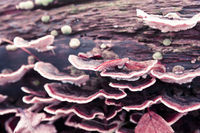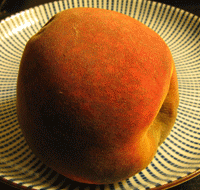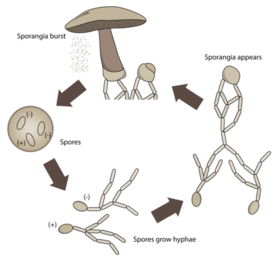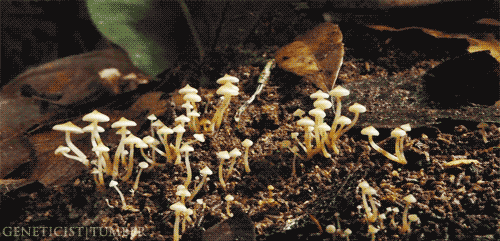User:MarjoleinStassen/Fungi
Contents
Fungus
Fungi (singular, fungus) are everywhere in the environment—in the soil; in lakes, rivers, and the seas; in the air (some are so tiny that they are carried by currents of wind or on the bodies of insects); and in and on plants and animals, including humans. Along with bacteria, fungi are responsible for the decay of organic matter and the release into the atmosphere of carbon, oxygen, nitrogen, and phosphorus. Many of them are eaten at the dinner table.
One of the most beneficial uses of a fungus came with the virtually accidental discovery of the antibiotic penicillin by Sir Alexander Fleming in 1928. Antibiotics, many of them derived from fungi, helped revolutionize the practice of medicine in the 20th century (see antibiotic; Fleming, Alexander). Not all fungi are beneficial, however. Some can cause serious diseases in plants and wreak havoc on whole segments of an agricultural economy. One of the best-known instances of fungus devastation in the 20th century was the destruction of elm trees in Europe and the United States by Dutch elm disease. The fungus responsible, Ceratocystis ulmi, probably arrived in Europe from Asia about the time of World War I. By the 1930s it had spread throughout Europe and Great Britain and killed thousands of trees. It appeared in the United States in 1930 and has since destroyed millions of elm trees. Overland spread of the disease normally occurs through transmission by elm bark beetles.
The word fungus (plural, fungi) is Latin for mushroom, and indeed, mushrooms are among the most commonly known fungi. For many years, most people—including scientists—considered fungi to be plants, mainly because, like plants, fungi do not move. Fungi also lack such complex plant structures as roots, stems, leaves, and flowers, though these traits are shared by some of the more primitive plants, such as mosses and liverworts. However, fungi lack some of the most important characteristics of plants. For example, fungi do not have chlorophyll and thus cannot undergo photosynthesis, which is a key trait all plants have in common. This factor, along with several other characteristics, led scientists to place the fungi into their own kingdom. Included within the kingdom Fungi, along with mushrooms, are molds, mildews, rusts, smuts, truffles, and yeasts. A general scientific term for fungi is mycota, from the Greek word for mushroom, mykes, and the study of these organisms is called mycology. Scientists estimate there are probably 1.5 million species of fungus worldwide, though only about 70,000 species have been described.
Molds
The fuzzy substance we see growing on old bread or fruit is mold, a mass of mycelia sprouting fruiting bodies that are often not immediately visible to the naked eye. The molds we see on dead organic matter such as old food are saprophytic. A mold is a fungus that grows in the form of multicellular filaments called hyphae. In contrast, fungi that can adopt a single celled growth habit are called yeasts.
Molds are a large and taxonomically diverse number of fungal species where the growth of hyphae results in discoloration and a fuzzy appearance, especially on food. The network of these tubular branching hyphae, called a mycelium, is considered a single organism. The hyphae are generally transparent, so the mycelium appears like very fine, fluffy white threads over the surface. Cross-walls (septa) may delimit connected compartments along the hyphae, each containing one or multiple, genetically identical nuclei. The dusty texture of many molds is caused by profuse production of asexual spores (conidia) formed by differentiation at the ends of hyphae. The mode of formation and shape of these spores is traditionally used to classify molds. Many of these spores are colored, making the fungus much more obvious to the human eye at this stage in its life-cycle.
What is the difference between Fungi and Mold?
Fungus
Fungi (singular fungus) are a kingdom of eukaryotic organisms. The fungi are heterotrophic organisms characterized by a chitinous cell wall, and in the majority of species, filamentous growth as multicellular hyphae forming a mycelium; some fungal species also grow as single cells. Sexual and asexual reproduction is via spores, often produced on specialized structures or in fruiting bodies. Yeasts, molds, and mushrooms are examples of fungi. The discipline of biology devoted to the study of fungi is known as mycology.
Molds
Molds (or moulds, see spelling differences) include all species of microscopic fungi that grow in the form of multicellular filaments, called hyphae. In contrast, microscopic fungi that grow as single cells are called yeasts. A connected network of these tubular branching hyphae has the same DNA and is considered a single organism, referred to as a colony or in more technical terms a mycelium. Molds do not form a specific taxonomic or phylogenetic grouping, but can be found in the divisions Zygomycota, Deuteromycota and Ascomycota. Although some molds cause disease or food spoilage, others are useful for their role in biodegradation or in the production of various foods, beverages, antibiotics and enzymes.
Where do Fungi live?
Fungi are very widely distributed throughout the world, particularly in the temperate and tropical regions where there is sufficient moisture for them to grow. They are less likely to be found in dry areas. Some few types of fungi have been reported in Arctic and Antarctic areas (some molds, after all, thrive on refrigerated food).
Fungi live both on land and in the water. Only a small portion of terrestrial fungi is normally seen above the ground. Most of the fungus consists of the complex network of hyphae, which grows just beneath the surface of the ground. The visible parts of fungi vary greatly in size. Some are so tiny that they cannot be seen without the aid of magnification. Others are quite large. Some mushrooms reach diameters of 8 to 10 inches (20 to 25 centimeters) and heights of 10 to 12 inches (25 to 30 centimeters). Bracket fungi that are 15 inches (38 centimeters) in diameter are fairly common; and mushrooms called puffballs have been known to grow to 60 inches (152 centimeters) in diameter. In 1992 scientists announced the discovery of a giant underground fungus, Armillaria ostoyae, that covered 1,500 acres (600 hectares) in Washington State. The only visible signs of its existence were aboveground mushrooms and a rot deadly to trees. In 2000 a larger Armillaria was found. This individual, which was discovered in the Blue Mountains of Oregon, covers 2,200 acres—about the size of 1,665 football fields. Experts estimate that it is at least 2,400 years old, making it not only the largest but also the oldest living organism on Earth.
Although fungi are distributed worldwide, the distribution of a specific species is limited by the temperature and moisture conditions of an area coupled with the available food supply. The best temperature for most fungi to thrive is from 68° to 86° F (20° to 30° C). Some types of fungi, however, do perfectly well at temperatures as high as 120° F (48° C), while a fairly large number of them do well at freezing temperatures, 32° F (0° C) or below.
How Fungi Reproduce
The reproduction of fungi can be either sexual or asexual. Sexual reproduction, as with other organisms, involves the fusion of two nuclei when two sex cells unite. This joining produces spores that can grow into new organisms. However, the majority of fungi reproduce asexually. The simplest asexual process is direct fragmentation, or breaking up, of the fungus body, or thallus. Each of the fragments develops into a new individual organism if environmental conditions are favorable. Such fragmentation usually is the result of outside natural forces. Some yeasts reproduce by simple cell division, wherein a yeast cell divides into two new yeast cells. Other yeast species reproduce by a method called budding: a bud develops on the surface of the yeast cell, after which the nucleus of the cell divides into two. After one of the nuclei moves into the bud, it is capable of starting a life of its own. Some species of the true fungi also reproduce via this method. Fungal reproduction is complex, reflecting the differences in lifestyles and genetic makeup within this diverse kingdom of organisms.
How do Fungi move?
Fungi are basically static. But they can spread either by forming reproductive spores that are carried on wind and rain (see the page Microbial Reproduction for more details) or by growing and extending their hyphae. Remember that hyphae are chains of fungal cells. Hyphae grow as new cells form at the tips, creating ever longer and branching chains of cells. It takes a lot to stop them, too. Hyphae are tough enough to punch through plant cell walls and the hard exoskeletons of insects (see the Fire Ant Killer story in the News section for a photo of an ant killed by a fungus).
Wordlist
- Hyphae - each of the branching filaments that make up the mycelium of a fungus.
- Eukaryotic - an organism consisting of a cell or cells in which the genetic material is DNA in the form of chromosomes contained within a distinct nucleus. Eukaryotes include all living organisms other than the eubacteria and archaebacteria
- Saprophytic - a plant, fungus, or microorganism that lives on dead or decaying organic matter.
Sources
1. http://en.wikipedia.org/wiki/Mold
2. http://en.wikipedia.org/wiki/Fungus
3. http://kids.britannica.com/comptons/article-225967/fungus
4. http://cloudmercury.deviantart.com/art/Growth-352894921



